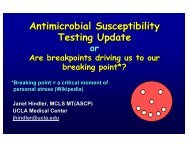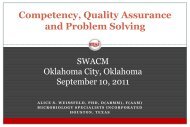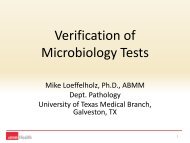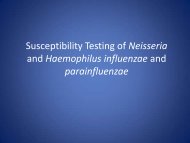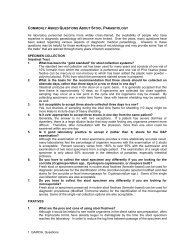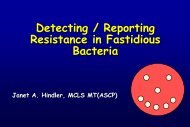Do it quick! Update on CLSI M35A2 - SWACM
Do it quick! Update on CLSI M35A2 - SWACM
Do it quick! Update on CLSI M35A2 - SWACM
You also want an ePaper? Increase the reach of your titles
YUMPU automatically turns print PDFs into web optimized ePapers that Google loves.
<str<strong>on</strong>g>Do</str<strong>on</strong>g> <str<strong>on</strong>g>it</str<strong>on</strong>g> <str<strong>on</strong>g>quick</str<strong>on</strong>g>!<br />
<str<strong>on</strong>g>Update</str<strong>on</strong>g> <strong>on</strong> <strong>CLSI</strong> <strong>M35A2</strong> –<br />
Rapid Methods for Identificati<strong>on</strong><br />
Mary K. York, Ph.D.<br />
Marykyork@gmail.com
Changes in sec<strong>on</strong>d ed<str<strong>on</strong>g>it</str<strong>on</strong>g>i<strong>on</strong><br />
More organisms<br />
Includes bioterrorist<br />
agents<br />
New safety precauti<strong>on</strong>s<br />
defined<br />
User friendly tables<br />
added<br />
New biochemicals<br />
Revised biochem<br />
secti<strong>on</strong>
References Prove Value :<br />
<str<strong>on</strong>g>Do</str<strong>on</strong>g>ern, G., R. Vautour, M. Gaudet, and B. Levy.<br />
1994. Clinical impact of rapid in v<str<strong>on</strong>g>it</str<strong>on</strong>g>ro<br />
susceptibil<str<strong>on</strong>g>it</str<strong>on</strong>g>y testing and bacterial<br />
identificati<strong>on</strong>.<br />
MIC 9.6 h from col<strong>on</strong>ies vs. 25.9 h- showed<br />
less mortal<str<strong>on</strong>g>it</str<strong>on</strong>g>y, length of stay and orders of<br />
laboratory tests<br />
Barenfanger, J., C. Drake, and G. Kacich.<br />
1999. Clinical and financial benef<str<strong>on</strong>g>it</str<strong>on</strong>g>s of rapid<br />
bacterial identificati<strong>on</strong> and antimicrobial<br />
susceptibil<str<strong>on</strong>g>it</str<strong>on</strong>g>y testing.<br />
evaluated evening vs. next day - 5 h<br />
difference - length of stay and cost was<br />
significantly less
Goals<br />
Rapid (same day) identificati<strong>on</strong> and<br />
reporting of >90% of pathogens<br />
Decrease costs of testing<br />
Increase safety of pers<strong>on</strong>nel<br />
Make use of microbiologists abil<str<strong>on</strong>g>it</str<strong>on</strong>g>y to<br />
recognize organisms<br />
Reduce need to c<strong>on</strong>firm - lim<str<strong>on</strong>g>it</str<strong>on</strong>g>ati<strong>on</strong>s<br />
stated
Grows <strong>on</strong> MAC<br />
Spreading Proteus
M35-A2 Nov. 2009<br />
M35A GRAM-NEGATIVE <strong>M35A2</strong> GRAM-NEGATIVE<br />
Escherichia coli Brucella species<br />
Haemophilus influenzae Campylobacter jejuni/coli<br />
Moraxella catarrhalis Cardiobacterium hominis<br />
Proteus species Eikenella corrodens<br />
Pseudom<strong>on</strong>as aeruginosa Francisella tularensis<br />
Kingella kingae<br />
Neisseria g<strong>on</strong>orrhoeae<br />
Neisseria mening<str<strong>on</strong>g>it</str<strong>on</strong>g>idis<br />
Neisseria lactamica
M35-A2 Nov. 2009<br />
M35A GRAM-POSITIVE <strong>M35A2</strong> GRAM-POSITIVE<br />
Enterococcus Listeria m<strong>on</strong>ocytogenes<br />
Staphylococcus aureus Staphylococcus lugdunensis<br />
Streptococcus agalactiae<br />
(Gr. B)<br />
Aerococcus viridans<br />
S. pneum<strong>on</strong>iae Streptococcus anginosus<br />
group (S. milleri)<br />
S. pyogenes (Gr. A) Viridans group streptococci
Example of new tables
“Is Use of Odor Safe”<br />
“Sniffing” plates is dangerous<br />
Opening plates <strong>on</strong> bench is safe<br />
(<strong>on</strong>ce dangerous <strong>on</strong>es & mold are ruled out)<br />
Odor is recognized when opening if<br />
str<strong>on</strong>g and distinctive<br />
Can be used in identificati<strong>on</strong>
Technologist must….<br />
Begin w<str<strong>on</strong>g>it</str<strong>on</strong>g>h pure col<strong>on</strong>y<br />
Recognize what <str<strong>on</strong>g>it</str<strong>on</strong>g> could be from<br />
typical col<strong>on</strong>y morphology<br />
Perform rapid tests accurately and<br />
read them correctly<br />
<str<strong>on</strong>g>Do</str<strong>on</strong>g>n’t cut corners…
Supervisor must…..<br />
Validate the competency of the staff<br />
doing tests<br />
Check to see that all tests are d<strong>on</strong>e<br />
Be sure that procedures are wr<str<strong>on</strong>g>it</str<strong>on</strong>g>ten and<br />
QC is d<strong>on</strong>e usually by lot
Perform a Gram stain<br />
unless growing <strong>on</strong><br />
MacC<strong>on</strong>key.<br />
Excepti<strong>on</strong>s will be noted<br />
as we proceed.
Not “Presumptive”<br />
>95% accuracy of rapid methods<br />
If cr<str<strong>on</strong>g>it</str<strong>on</strong>g>eria are met, no further testing is<br />
required for defin<str<strong>on</strong>g>it</str<strong>on</strong>g>ive identificati<strong>on</strong><br />
Excepti<strong>on</strong>: will further testing provide<br />
informati<strong>on</strong> clinically useful for patient<br />
outcome (e.g. c<strong>on</strong>firm a bioterorist<br />
identificati<strong>on</strong>)
Start w<str<strong>on</strong>g>it</str<strong>on</strong>g>h Indole and Oxidase Test<br />
Cinnamaldehyde is blue<br />
Required for anaerobes<br />
Benzaldehyde (Kovacs) in acid alcohol, not amyl, is red<br />
Can be used for tube test
Many rapid indole tests….
Rapid Identificati<strong>on</strong> of E.coli<br />
•Indole +<br />
•Oxidase -<br />
•Gram-negative rod<br />
•Lactose pos<str<strong>on</strong>g>it</str<strong>on</strong>g>ive<br />
•Beta-hemolytic or PYR<br />
negative<br />
= E. coli
PYR negative = E. coli<br />
1. Wet disk slightly<br />
2. Add reagent after 2 minutes<br />
3. <str<strong>on</strong>g>Do</str<strong>on</strong>g> not use selective media
PYR reacti<strong>on</strong>s<br />
Genus Indole Lactose PYR<br />
C<str<strong>on</strong>g>it</str<strong>on</strong>g>robacter Some + V +<br />
E. coli + V -<br />
Klebsiella Some + + +<br />
Yersinia Some + - +<br />
+<br />
Enterobacter - + -<br />
+<br />
Serratia - + -<br />
Morganella + - -<br />
Proteus Some + - -<br />
Providencia + - -<br />
Edwardsiella + - -<br />
Hafnia - + -<br />
Shigella Some + - -<br />
Salm<strong>on</strong>ella - - +<br />
-<br />
+
Brucella<br />
blood, lymph nodes, body fluids<br />
• <str<strong>on</strong>g>Do</str<strong>on</strong>g>es not grow <strong>on</strong> MacC<strong>on</strong>key<br />
• N<strong>on</strong>- hemolytic, slow-growing col<strong>on</strong>ies<br />
• Tiny cocco-bacilli<br />
• Catalase pos<str<strong>on</strong>g>it</str<strong>on</strong>g>ive<br />
• Oxidase pos<str<strong>on</strong>g>it</str<strong>on</strong>g>ive<br />
• Indole negative<br />
• Rapid pos<str<strong>on</strong>g>it</str<strong>on</strong>g>ive urease (2 hours)<br />
• Phenylalanine deaminase negative
This is Brucella unless<br />
proven otherwise<br />
Work in a BSC<br />
C<strong>on</strong>firm w<str<strong>on</strong>g>it</str<strong>on</strong>g>h urease<br />
Reportable disease<br />
Bioterrorism
Urease rapid test-incubate 2 h<br />
-<br />
+<br />
+ w<str<strong>on</strong>g>it</str<strong>on</strong>g>h Fe Cl<br />
Phenylalanine deaminase test
Brucella Diagnosis<br />
Symptoms are n<strong>on</strong>-specific<br />
Onset is insidious<br />
Risks are eating raw dairy products or<br />
working in a microbiology laboratory<br />
W<str<strong>on</strong>g>it</str<strong>on</strong>g>hout treatment there is no cure :<br />
<str<strong>on</strong>g>Do</str<strong>on</strong>g>xycycline plus rifampin
Other Oxidase + catalase + urease +<br />
Paracoccus yeei (vacuoles and round cells)<br />
Psychrobacter immobilis (rose odor, likes<br />
20°C)<br />
Methylobacterium spp. (pink at 72 hours)<br />
Psychrobacter phenylpyruvicus (PDA +)<br />
Oligella ureolytica (PDA +, motile)
Paracoccus yeei
Campylobacter in stools<br />
Distinctive col<strong>on</strong>y <strong>on</strong><br />
selective media at<br />
42°C<br />
Oxidase pos<str<strong>on</strong>g>it</str<strong>on</strong>g>ive<br />
Catalase pos<str<strong>on</strong>g>it</str<strong>on</strong>g>ive<br />
Gull wing gram stain<br />
Darting motil<str<strong>on</strong>g>it</str<strong>on</strong>g>y
Pos<str<strong>on</strong>g>it</str<strong>on</strong>g>ive<br />
hippurate<br />
Is Campylobacter<br />
jejuni
Pos<str<strong>on</strong>g>it</str<strong>on</strong>g>ive Indoxyl Acetate<br />
is C. jejuni/coli<br />
5-10 minute test for blue color
Indoxyl acetate<br />
C. lari is negative<br />
Can also be used<br />
for identificati<strong>on</strong> of<br />
Moraxella<br />
catarrhalis
Col<strong>on</strong>ies move when pushed
Identificati<strong>on</strong> of M. catarrhalis<br />
Gram negative<br />
diplococci<br />
Indoxyl acetate<br />
or butyrate<br />
pos<str<strong>on</strong>g>it</str<strong>on</strong>g>ive<br />
Actually all<br />
Moraxella and<br />
Acinetobacter are<br />
butyrate + but they<br />
are coccobacilli
HACEK bacteria<br />
BAP & MAC<br />
Pos<str<strong>on</strong>g>it</str<strong>on</strong>g>ive blood culture
Cardiobacterium hominis
Cardiobacterium hominis<br />
Indole-pos<str<strong>on</strong>g>it</str<strong>on</strong>g>ive in blood culture<br />
Oxidase-pos<str<strong>on</strong>g>it</str<strong>on</strong>g>ive<br />
Catalase-negative<br />
N<strong>on</strong>-hemolytic<br />
Chr<strong>on</strong>ic endocard<str<strong>on</strong>g>it</str<strong>on</strong>g>is<br />
Slow growing<br />
Fatal if not treated-beta-lactam surgery<br />
N<str<strong>on</strong>g>it</str<strong>on</strong>g>rate-negative if needed to c<strong>on</strong>firm<br />
<str<strong>on</strong>g>Do</str<strong>on</strong>g>n’t let the gen<str<strong>on</strong>g>it</str<strong>on</strong>g>al isolate Pasteurella bettyae or<br />
rare isolate Sutt<strong>on</strong>ella indologenes c<strong>on</strong>fuse you
Oxidase +, catalase -, indole -<br />
Eikenella corrodens<br />
N<strong>on</strong>-hemolytic-sticks in agar<br />
Odor of bleach<br />
Slight yellow
Blood agar hemolysis-<br />
Found in joint and<br />
blood infecti<strong>on</strong>s in<br />
children<br />
Kingella
Kingella kingae<br />
Oxidase + Catalase - Indole -
Francisella tularensis<br />
If growth takes l<strong>on</strong>ger than 24 h, may be<br />
Francisella which does not satell<str<strong>on</strong>g>it</str<strong>on</strong>g>e<br />
• Grows <strong>on</strong> CHOC but not <strong>on</strong> BAP.<br />
• Oxidase-negative; catalase weak.<br />
• No k<str<strong>on</strong>g>it</str<strong>on</strong>g> will identify<br />
• <str<strong>on</strong>g>Do</str<strong>on</strong>g> cefinase-result is pos<str<strong>on</strong>g>it</str<strong>on</strong>g>ive.<br />
• Send to health department for c<strong>on</strong>firmati<strong>on</strong><br />
• Safety c<strong>on</strong>cerns
No growth <strong>on</strong> BAP<br />
Tiny rod in smear
Rapid identificati<strong>on</strong><br />
Oxidase - Catalase V Indole -
Francisella is<br />
beta<br />
lactamase<br />
pos<str<strong>on</strong>g>it</str<strong>on</strong>g>ive
Francisella tularensis - BSL III
Identificati<strong>on</strong> of<br />
Haemophilus influenzae<br />
Small gram-negative<br />
coccobacilli<br />
Growth of large<br />
col<strong>on</strong>ies <strong>on</strong>ly <strong>on</strong><br />
CHOC in 24 h or<br />
around<br />
staphylococci<br />
Satell<str<strong>on</strong>g>it</str<strong>on</strong>g>e separates <str<strong>on</strong>g>it</str<strong>on</strong>g><br />
from Francisella
Neisseria species<br />
Gram-negative diplococci<br />
Oxidase pos<str<strong>on</strong>g>it</str<strong>on</strong>g>ive<br />
Species identificati<strong>on</strong> by rapid<br />
test and growth <strong>on</strong> various media
Neisseria mening<str<strong>on</strong>g>it</str<strong>on</strong>g>idis<br />
Col<strong>on</strong>y grows <strong>on</strong> BAP as glistening and n<strong>on</strong>hemolytic<br />
and not yellow pigmented<br />
Delta -glutamyl amino peptidase – pos<str<strong>on</strong>g>it</str<strong>on</strong>g>ive<br />
• May be carried as normal flora in the throat<br />
• Isolated from the cervix or urethra of men or women<br />
• Sporadic cases or epidemics of mening<str<strong>on</strong>g>it</str<strong>on</strong>g>is.<br />
• 13 serogroups<br />
• Use cauti<strong>on</strong> BSC - vaccine available for lab staff.
Neisseria lactamica<br />
Col<strong>on</strong>y grows <strong>on</strong> BAP n<strong>on</strong>-hemolytic and not<br />
yellow pigmented<br />
Beta galactosidase– pos<str<strong>on</strong>g>it</str<strong>on</strong>g>ive<br />
• Associated w<str<strong>on</strong>g>it</str<strong>on</strong>g>h ocular infecti<strong>on</strong>s
NET test 30 min<br />
•Blue - Pos<str<strong>on</strong>g>it</str<strong>on</strong>g>ive for betagalactosidase:<br />
Neisseria lactamica<br />
•Yellow – Pos<str<strong>on</strong>g>it</str<strong>on</strong>g>ive for<br />
gammaglutamylaminopeptidase:<br />
Neisseria mening<str<strong>on</strong>g>it</str<strong>on</strong>g>idis
Next step if not e<str<strong>on</strong>g>it</str<strong>on</strong>g>her of these species or<br />
rule out Moraxella<br />
Moraxella catarrhalis is negative for both<br />
but pos<str<strong>on</strong>g>it</str<strong>on</strong>g>ive for e<str<strong>on</strong>g>it</str<strong>on</strong>g>her butyrate or indoxyl<br />
acetate<br />
c<strong>on</strong>firm lack of growth <strong>on</strong> nutrient agar.<br />
• Nutrient agar<br />
• TSA<br />
• MH<br />
Or does <str<strong>on</strong>g>it</str<strong>on</strong>g> grow <strong>on</strong> Thayer Martin =<br />
vancomycin and colistin resistant
Neisseria<br />
g<strong>on</strong>orrhoeae<br />
Gram negative diplococci<br />
Oxidase-pos<str<strong>on</strong>g>it</str<strong>on</strong>g>ive<br />
Catalase-pos<str<strong>on</strong>g>it</str<strong>on</strong>g>ive -<br />
str<strong>on</strong>g w<str<strong>on</strong>g>it</str<strong>on</strong>g>h 30% peroxide<br />
No growth <strong>on</strong> nutrient agar and no pigment<br />
…..Or Colistin/ polymyxin B resistant by growth<br />
<strong>on</strong> selective medium<br />
K<str<strong>on</strong>g>it</str<strong>on</strong>g> identificati<strong>on</strong> not other Neisseria<br />
Usually proline pos<str<strong>on</strong>g>it</str<strong>on</strong>g>ive
Neisseria Table<br />
All are catalase + and oxidase +;<br />
GC is 4+ catalase<br />
MH Bgal Glut Pro<br />
N. mening<str<strong>on</strong>g>it</str<strong>on</strong>g>idis + + v<br />
N. lactamica + + +<br />
N. g<strong>on</strong>orrhoeae - +<br />
N. cineria + +<br />
Neisseria (other)<br />
Moraxella<br />
+ v
Staphylococcus aureus - BAP
Staphylococcus Latex tests<br />
Staph Latex<br />
Fibrinogen<br />
IgG to attach to Protein A
Staphylococcus saprophyticus<br />
Latex test can be<br />
pos<str<strong>on</strong>g>it</str<strong>on</strong>g>ive<br />
Slide coagulase is<br />
negative<br />
Gram-pos<str<strong>on</strong>g>it</str<strong>on</strong>g>ive cocci in urine
S. lugdunensis can be Latex + or -<br />
Significant<br />
cause of<br />
bacteremia<br />
and wound<br />
infecti<strong>on</strong>s<br />
Recognize<br />
col<strong>on</strong>y<br />
Catalase +<br />
Can be slide<br />
coagulase + or<br />
latex +
Staphylococcus lugdunensis<br />
Clumpy slide test<br />
Negative tube test<br />
PYR Magenta
Algor<str<strong>on</strong>g>it</str<strong>on</strong>g>hm for Staphylococcus ID
Aerococcus viridans<br />
Alpha col<strong>on</strong>y<br />
Tetrads<br />
PYR pos<str<strong>on</strong>g>it</str<strong>on</strong>g>ive<br />
PYR +
PYR-pos<str<strong>on</strong>g>it</str<strong>on</strong>g>ive α hemolytic<br />
catalase negative col<strong>on</strong>y
Streptococcus PYR - LAP +<br />
Enterococcus PYR + LAP +<br />
Aerococcus viridans PYR + LAP -<br />
Courtesy of Color Atlas of Medical Bacteriology, ASM Press, 2004
•Streptococcus anginosus (“milleri” grp)<br />
• Alpha or Beta-hemolytic <strong>on</strong> BAP<br />
• Pinpoint col<strong>on</strong>ies
Group A, C, G Streptococcus<br />
vs. Streptococcus anginosus<br />
Odor of vanilla<br />
Tiny col<strong>on</strong>ies<br />
PYR not pos<str<strong>on</strong>g>it</str<strong>on</strong>g>ive if A
Listeria m<strong>on</strong>ocytogenes<br />
(blood, CSF, products of c<strong>on</strong>cepti<strong>on</strong>)<br />
Pos<str<strong>on</strong>g>it</str<strong>on</strong>g>ive rapid hippurate<br />
Tumbling motil<str<strong>on</strong>g>it</str<strong>on</strong>g>y<br />
Catalase pos<str<strong>on</strong>g>it</str<strong>on</strong>g>ive
Bach Mai<br />
Hanoi,Vietnam
Rapid testing does make a<br />
difference<br />
Questi<strong>on</strong>s?



